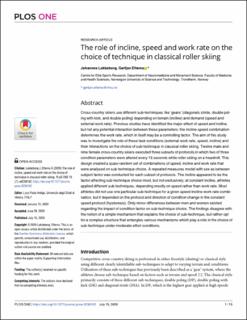| dc.contributor.author | Løkkeborg, Johannes Alnes | |
| dc.contributor.author | Ettema, Gerardus Johannes C | |
| dc.date.accessioned | 2021-09-14T08:20:42Z | |
| dc.date.available | 2021-09-14T08:20:42Z | |
| dc.date.created | 2020-08-21T10:54:19Z | |
| dc.date.issued | 2020 | |
| dc.identifier.citation | PLOS ONE. 2020, 15 (7), 1-15. | en_US |
| dc.identifier.issn | 1932-6203 | |
| dc.identifier.uri | https://hdl.handle.net/11250/2776375 | |
| dc.description.abstract | Cross-country skiers use different sub-techniques like ‘gears’ (diagonals stride, double poling with kick, and double poling) depending on terrain (incline) and demand (speed and external work rate). Previous studies have identified the major effect of speed and incline, but not any potential interaction between these parameters: the incline-speed combination determines the work rate, which in itself may be a controlling factor. The aim of this study was to investigate the role of these task conditions (external work rate, speed, incline) and their interactions on the choice of sub-technique in classical roller skiing. Twelve male and nine female cross-country skiers executed three subsets of protocols in which two of three condition parameters were altered every 15 seconds while roller skiing on a treadmill. This design created a quasi-random set of combinations of speed, incline and work rate that were analysed on sub-technique choice. A repeated measures model with sex as between subject factor was conducted for each subset of protocols. The incline appeared to be the factor affecting sub-technique choice most, but not exclusively; at constant incline, athletes applied different sub-techniques, depending mostly on speed rather than work rate. Most athletes did not use one particular sub-technique for a given speed-incline-work rate combination, but it depended on the protocol and direction of condition change in the constant speed protocol (hysteresis). Only minor differences between men and women existed regarding the impact of condition factor on sub-technique choice. The findings disagree with the notion of a simple mechanism that explains the choice of sub-technique, but rather opt for a complex structure that entangles various mechanisms which play a role in the choice of sub-technique under moderate effort conditions. | en_US |
| dc.language.iso | eng | en_US |
| dc.publisher | Public Library of Science, PLOS | en_US |
| dc.rights | Navngivelse 4.0 Internasjonal | * |
| dc.rights.uri | http://creativecommons.org/licenses/by/4.0/deed.no | * |
| dc.title | The role of incline, speed and work rate on the choice of technique in classical roller skiing | en_US |
| dc.type | Peer reviewed | en_US |
| dc.type | Journal article | en_US |
| dc.description.version | publishedVersion | en_US |
| dc.source.pagenumber | 1-15 | en_US |
| dc.source.volume | 15 | en_US |
| dc.source.journal | PLOS ONE | en_US |
| dc.source.issue | 7 | en_US |
| dc.identifier.doi | 10.1371/journal.pone.0236102 | |
| dc.identifier.cristin | 1824441 | |
| dc.description.localcode | Copyright: © 2020 Løkkeborg, Ettema. This is an open access article distributed under the terms of the Creative Commons Attribution License, which permits unrestricted use, distribution, and reproduction in any medium, provided the original author and source are credited. | en_US |
| cristin.ispublished | true | |
| cristin.fulltext | original | |
| cristin.qualitycode | 1 | |

